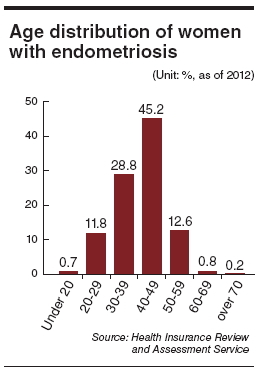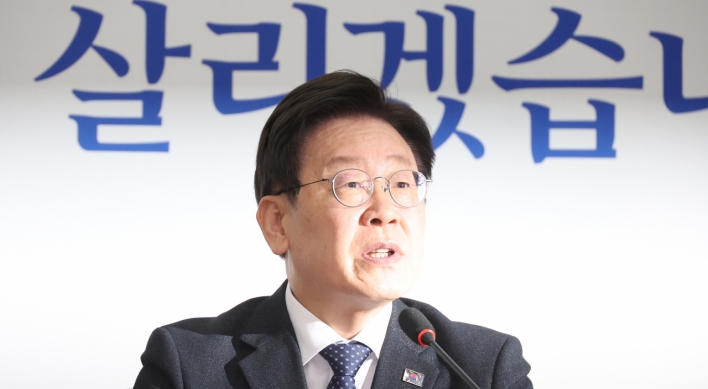Severe cramps, heavy periods may signal endometriosis
By Korea HeraldPublished : Oct. 17, 2013 - 20:09
The number of endometriosis patients in Korea is growing fast, probably because of frequent intake of fast food and irregular life patterns, doctors said.
The disease involves the presence and growth of functioning endometrial tissue in places other than the uterus, often resulting in severe pain and infertility.
The disease involves the presence and growth of functioning endometrial tissue in places other than the uterus, often resulting in severe pain and infertility.

According to the Health Insurance and Assessment Service, the number of patients diagnosed with the disease and receiving treatment surged more than 50 percent from 53,000 in 2008 to 80,000 last year.
Treatment costs also jumped 35.4 percent from 28.1 billion won ($26.4 million) in 2008 to 38.1 billion won in 2012, the state-run agency said.
“The health disorder was found in many women in the West in the past,” said Lee Jeong-jae, a professor at the Department of Obstetrics and Gynecology at Soon Chun Hyang University Hospital in Seoul.
“But the growing number of endometriosis patients in Korea indicates that the rising prevalence rate of the disease may have resulted from westernized eating habits, excessive intake of fast food and irregular life patterns,” he said. Genetic factors may predispose some people to the disorder, he added.
The data showed that the disease was mostly found in women in their 30s and 40s, representing 74 percent of patients, followed by women in their 20s and women in their 50s with 12.6 percent and 11.8 percent, respectively.
Any woman who has periods can get the disease. Endometriosis in post-menopausal women has been reported but is uncommon.
Severe and constant cramps, heavy periods or pelvic pain can be signs of endometriosis, so women suffering these symptoms should see a doctor immediately, Lee said.
Particularly, young patients with endometriosis need to have immediate treatment or surgery as the condetion could lead to fertility.
The cause of endometriosis is unknown, Lee says. One common theory is retrograde menstruation in which endometrial tissue is sent to other areas of the body ― frequently to the fallopian tubes and the pelvic and abdominal cavity ― by regressing menstrual flow.
Endometriosis is not life-threatening disease, but a common. .
When diagnosed with endometriosis, the first step is controlling the pain with a prescription pain reliever. If patients experience pain even with the drug, doctors may recommend patients to take hormone therapy to stop the natural menstrual cycle.
In severe cases, patients may undergo a surgical procedure called laparoscopy to cut or burn the affected area away.
Endometriosis can cause infertility by spurring the production of hormones and other substances that stop ovulation, fertilization of the egg, and implantation of the embryo. But many women diagnosed with endometriosis can get pregnant. Pregnancy and breast feeding save endometriosis patients from pain because they suppress menstruation, Lee said.
By Cho Chung-un (christory@heraldcorp.com)
Treatment costs also jumped 35.4 percent from 28.1 billion won ($26.4 million) in 2008 to 38.1 billion won in 2012, the state-run agency said.
“The health disorder was found in many women in the West in the past,” said Lee Jeong-jae, a professor at the Department of Obstetrics and Gynecology at Soon Chun Hyang University Hospital in Seoul.
“But the growing number of endometriosis patients in Korea indicates that the rising prevalence rate of the disease may have resulted from westernized eating habits, excessive intake of fast food and irregular life patterns,” he said. Genetic factors may predispose some people to the disorder, he added.
The data showed that the disease was mostly found in women in their 30s and 40s, representing 74 percent of patients, followed by women in their 20s and women in their 50s with 12.6 percent and 11.8 percent, respectively.
Any woman who has periods can get the disease. Endometriosis in post-menopausal women has been reported but is uncommon.
Severe and constant cramps, heavy periods or pelvic pain can be signs of endometriosis, so women suffering these symptoms should see a doctor immediately, Lee said.
Particularly, young patients with endometriosis need to have immediate treatment or surgery as the condetion could lead to fertility.
The cause of endometriosis is unknown, Lee says. One common theory is retrograde menstruation in which endometrial tissue is sent to other areas of the body ― frequently to the fallopian tubes and the pelvic and abdominal cavity ― by regressing menstrual flow.
Endometriosis is not life-threatening disease, but a common. .
When diagnosed with endometriosis, the first step is controlling the pain with a prescription pain reliever. If patients experience pain even with the drug, doctors may recommend patients to take hormone therapy to stop the natural menstrual cycle.
In severe cases, patients may undergo a surgical procedure called laparoscopy to cut or burn the affected area away.
Endometriosis can cause infertility by spurring the production of hormones and other substances that stop ovulation, fertilization of the egg, and implantation of the embryo. But many women diagnosed with endometriosis can get pregnant. Pregnancy and breast feeding save endometriosis patients from pain because they suppress menstruation, Lee said.
By Cho Chung-un (christory@heraldcorp.com)
-
Articles by Korea Herald








![[Hello India] Hyundai Motor vows to boost 'clean mobility' in India](http://res.heraldm.com/phpwas/restmb_idxmake.php?idx=644&simg=/content/image/2024/04/25/20240425050672_0.jpg&u=)










